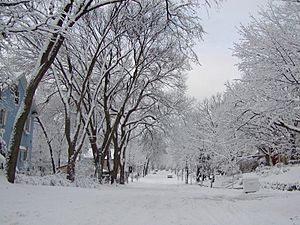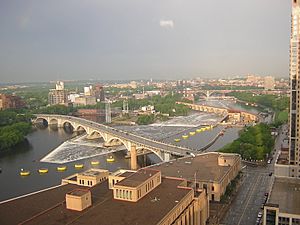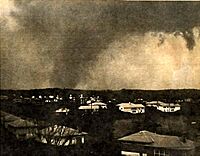Climate of Minneapolis–Saint Paul facts for kids
The climate of Minneapolis–Saint Paul describes the usual weather patterns and big weather events in the Minneapolis–Saint Paul area. This area is in east-central Minnesota. Minneapolis and St. Paul are often called the Twin Cities. They form the 15th largest metropolitan area in the United States. About 3.6 million people live here. This is around 60% of Minnesota's population.
Because it's in the northern and central U.S., the Twin Cities has the coldest average temperature of any big city area in the nation. Winters are very cold. Summers are warm and humid. Snow often falls in winter. Thunderstorms with heavy rain happen in spring, summer, and autumn. Even though winter is cold, the area gets more sunlight in mid-winter than many warmer places. This includes all the Great Lakes states and parts of the South.
Contents
General Climate Facts
The Twin Cities climate is called a hot-summer humid continental climate. This means it has hot summers and cold winters. The weather here can be very surprising. It often has extreme highs and lows. For example, the Twin Cities has a record high temperature of 108 °F (42 °C). This is hotter than the entire state of Florida. Florida is almost 1000 miles closer to the equator!
On the other hand, winter temperatures in the Twin Cities are colder than in any other major U.S. city. They are about the same as in Anchorage, Alaska. Anchorage is about 1,000 miles (1,600 km) closer to the North Pole. The Twin Cities can also have dry periods and floods. It is also windier on average than Chicago, Illinois.
Temperatures in the Twin Cities
| Weather chart for Minneapolis–Saint Paul | |||||||||||||||||||||||||||||||||||||||||||||||
|---|---|---|---|---|---|---|---|---|---|---|---|---|---|---|---|---|---|---|---|---|---|---|---|---|---|---|---|---|---|---|---|---|---|---|---|---|---|---|---|---|---|---|---|---|---|---|---|
| J | F | M | A | M | J | J | A | S | O | N | D | ||||||||||||||||||||||||||||||||||||
|
0.9
24
8
|
0.8
29
13
|
1.9
41
24
|
2.7
58
37
|
3.4
69
49
|
4.3
79
59
|
4
83
64
|
4.3
81
62
|
3.1
72
52
|
2.4
58
40
|
1.8
41
26
|
1.2
27
12
|
||||||||||||||||||||||||||||||||||||
| temperatures in °F precipitation totals in inches source: NOAA |
|||||||||||||||||||||||||||||||||||||||||||||||
|
Metric conversion
|
|||||||||||||||||||||||||||||||||||||||||||||||
Because the Twin Cities are in the middle of North America, they have huge temperature changes. Temperatures here range from an average of 15.6 °F (−9.1 °C) in January. They go up to 73.8 °F (23.2 °C) in July. There are no mountains or big barriers to stop cold air from Canada. This means very cold air masses often reach the Twin Cities in winter. These bring low temperatures and sometimes strong winds.
The Twin Cities has similar summer temperatures to nearby cities like Chicago. But the cold air from the Arctic makes its average winter temperature much lower than Chicago's. Even though it's only 350 miles (563 km) from Chicago, the Twin Cities' average January temperature is 15.6 °F (−9.1 °C). Chicago's is 23.8 °F (−4.6 °C). In summer, Minneapolis can get very hot from May to September. It also gets very humid.
Temperature Records
Weather records for the Twin Cities go back to October 1, 1872. The coldest temperature ever recorded was −41 °F (−41 °C). This happened on January 21, 1888. The hottest temperature ever was 108 °F (42 °C). This happened on July 14, 1936, during the Dust Bowl years.
City Heat Effect
A big factor for temperatures in the Twin Cities is the urban heat island effect. This means that cities tend to be warmer than the countryside around them. Lots of concrete and asphalt, plus tall buildings, trap heat. This makes temperatures warmer, especially at night. For example, the average yearly temperature at the Minneapolis St. Paul International Airport is 45.4 °F (7 °C). This is warmer than Rochester (43.4 °F (6 °C)) and Mankato (44.7 °F (7 °C)). Both of those cities are further south.
Rain and Snow

The Twin Cities gets many types of precipitation. Rain is most common in summer. Snow, hail, sleet, and freezing rain happen in winter. June, July, and August get almost half of the yearly rain. Most of this rain comes from thunderstorms. These are common in summer. Thunderstorms can happen from March to November. Sometimes, thundersnow occurs. This is when thunder and lightning happen during a snowstorm.
In spring and summer, some thunderstorms are severe. These storms can bring strong winds, large hail, and sometimes a tornado. The Twin Cities has had several major derecho events. A derecho is a widespread, long-lived wind storm. One big derecho happened in May 1998. It traveled from South Dakota to New York. Summer thunderstorms are often fueled by very humid air. The dew point can reach into the 70s °F (21 °C). Sometimes it even reaches 80 °F (27 °C).

Winter precipitation comes in different forms. Snow is the main type. But freezing rain, hail, sleet, and even rain are possible. Big storm systems can bring lots of snow. They can even cause blizzard conditions. The Twin Cities gets about 45.3 inches (115.1 cm) of snow each year. There are about 100 days a year with at least 1 inch (2.5 cm) of snow on the ground. The most snow in one winter was 98.6 inches (250 cm) in 1983–1984. The least was 14.2 inches (36.1 cm) in 1930–1931.
Big Weather Events
Tornadoes

The Twin Cities area is near the northern edge of Tornado Alley. This means tornadoes happen here almost every year. The first tornado recorded in the Twin Cities was in 1820. It happened at Fort Snelling. A strong tornado hit St. Paul in 1891.
The worst tornado event for the Twin Cities was on May 6, 1965. On that day, six tornadoes touched down. They hit areas in and around the western and northern metro area. Sadly, 13 people died and over 600 were hurt. Four of these tornadoes were very strong, rated F4. Two of them hit Fridley, Minnesota about an hour apart. This event was special because it was the first time civil defense sirens were used in Minnesota to warn people. TV stations also gave live updates. Many people believe this helped save lives.
In 1981, a tornado called the Har-Mar tornado hit Minneapolis. It then moved to the northern suburbs. It caused damage and killed one person near Lake Harriet. On July 18, 1986, a tornado hit Fridley. A news helicopter from KARE 11 filmed it live. This aerial video was very new at the time.
On May 25, 2008, an EF3 tornado hit the town of Hugo. This tornado damaged or destroyed many homes. It caused about $25 million in damage.
Derechos
Derechos are wind storms that cover large areas. They can cause a lot of damage, even if their winds are not as strong as a tornado's. The most expensive severe weather event in Twin Cities history was a derecho on May 15, 1998. Large hail and strong winds caused about $1 billion in damage. Two weeks later, on May 30, another big derecho hit. It had winds over 80 miles per hour (130 km/h) across much of the Twin Cities. These two events together caused $1.5 billion in damage. They led to the biggest cleanup project in Minnesota's history.
Snowstorms
On November 11, 1940, the Armistice Day Blizzard hit southeast Minnesota. It killed 60 people in the state. The Twin Cities got 17 inches (43 cm) of snow. Temperatures dropped almost sixty degrees in one day. The biggest snowstorm for most of the Twin Cities was the Halloween Blizzard. This happened from October 31 to November 2, 1991. Officially, 28.4 inches (72 cm) of snow fell at the Twin Cities airport. This was the largest early-season snowstorm for the whole region.
Floods
The biggest flash flood in Twin Cities history happened on July 23–24, 1987. It was called The Super Storm. More rain fell during this event than any other recorded in Twin Cities history. The storm damaged 9,000 homes. It caused $27 million in damage. Some areas in the southern metro got 11 inches (279 mm) of rain. The 9.15 inches (232 mm) that fell on July 23 is the most rain in a single day for the Twin Cities. This event was voted the eighth most important weather event in Minnesota during the 20th century.
The Minnesota River and Mississippi River both flow through the Twin Cities. Because of this, some river flooding happens almost every year. The worst floods on these rivers in Twin Cities history were in 1965. Other big floods happened in 1969, 1993, 1997, and 2001.



